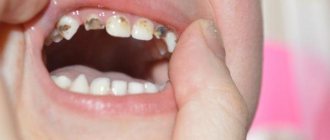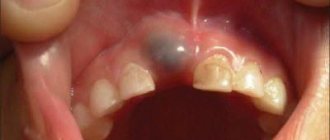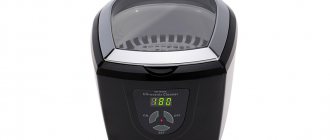From this article you will learn:
- how to silver teeth - photo,
- indications and contraindications for the procedure,
- preparations for silvering teeth in children.
The article was written by a practicing dentist.
Silvering of teeth is a conservative method of treating caries of primary teeth in children, which consists of impregnating the caries-affected areas of the tooth with silver. This method is most often used in children aged 2-3 years, or in children over 3 years old - with a strong fear of the dentist. The method has its drawbacks, and is not indicated for every child, but in some cases it is the only way to do without removing teeth before their physiological change.
In dentistry, the following drugs are usually used to silver baby teeth in children: Saforide or two-component Argenate. The effectiveness of silver plating will largely depend on the stage of the carious process. The method will be especially effective in the initial form of caries in the white spot stage, as well as superficial caries (i.e. in cases where the carious process does not extend beyond the enamel layer). With average caries, when dentin is already damaged, the method has very limited effectiveness.
Teeth after silvering: photo
Silvering of teeth in children can be performed from the moment they erupt (from 6 months), the procedure does not require anesthesia and is well tolerated even by emotionally unbalanced children. The visible disadvantage of the method is the change in the color of the teeth - which must be warned in advance to the child’s parents, having obtained their consent to use the method. In this case, only demineralized areas of tooth enamel affected by caries change their color (the color of healthy enamel does not change).
Why are teeth silvered?
A feature of early childhood caries is its very rapid progression, which often leads to tooth loss. Some parents do not consider this a serious problem, since temporary teeth should fall out soon anyway. But premature loss of primary occlusion elements can cause orthodontic problems in adults. Therefore, it is extremely important to stop the development of the disease as early as possible.
If you have time to silver the milk teeth at the white spot stage, you can avoid the spread of the process deep into the tissues and preserve them until the time of natural replacement.
Optimal age for treatment
Doctors advise silvering the teeth of children under three years of age. This is due to the fact that at this age children very often refuse to undergo regular dental treatment and are terrified of drills and other dental instruments.
With children four years old and older, doctors most often manage to come to an agreement. Doctors offer them gentle filling techniques, during which they almost never experience any discomfort. But, if the child is emotionally unstable, the need for silver application may arise even at age five.
What is silver dental treatment?
The method of silvering children's teeth is not new in dentistry. For many decades, doctors have been using this procedure to treat the initial stages of caries in young children.
Silver plating is not an entirely accurate term. For treatment, not pure noble metal is used, but its active salts. The composition of the medicinal product includes silver fluoride diamine. When it interacts with the inorganic component of the enamel, microscopic crystals of silver phosphate and calcium fluoride are formed, which seal the dentinal tubules and prevent the entry of pathogenic microorganisms. At the same time, silver ions suppress microbial activity.
The tooth surface treated in this way becomes much denser and more resistant to the action of acids that enter with food or are released by bacteria in the course of their life.
Today, the most common drugs for silvering teeth in children are the Japanese “Saforaid” and the Russian “Argenat”. They have a comprehensive therapeutic and preventive effect on tooth enamel and are absolutely safe for the child’s health.
Content:
- What is silvering of teeth
- In what cases can teeth be silvered?
- Advantages of the technique
- Disadvantages of the technique
- Modern alternatives to silvering teeth
Caries in primary teeth is not uncommon.
On the contrary, almost all children with temporary occlusion encounter it. The disease occurs due to genetic predisposition, failure to comply with basic rules of oral hygiene, deficiency of vitamins and minerals, and consumption of large amounts of sweets. Unfortunately, not all parents pay due attention to the condition of their children's teeth. Many are convinced that there is no reason to worry - very soon the temporary units will be replaced by permanent ones. Dentists do not agree with this opinion. It is necessary to preserve the primary bite until the molars erupt in order to:
- protect permanent units from destruction;
- reduce the risk of dental deformities;
- protect the gastrointestinal tract from unnecessary stress.
If a cavity appears in a tooth, you should definitely show your child to a doctor. Most likely, the doctor will perform a filling. But it is possible that silvering of teeth will be used as a therapeutic measure. Let's look at this procedure in more detail.
How are baby teeth silvered?
The silvering technique is simple and does not take much time. The tooth surface affected by caries is thoroughly cleaned of plaque and the medicinal preparation is carefully applied with a cotton applicator. That's all. This procedure does not cause any discomfort or negative reaction in the child.
How many times it is necessary to repeat the silvering process is decided individually in each case. Usually 3-5 procedures are enough, which are performed daily or every other day. Such courses are repeated every 4-6 months.
Advantages
Silvering makes a huge contribution to the oral care of young children.
At the same time, it has a number of undeniable advantages:
- This procedure is absolutely painless and safe . It can replace unpleasant treatment with a drill, which can cause both accidental physical and psychological trauma. The kids go for silvering without tears or fear.
- Availability of this type of treatment . Processing one unit costs from 100 to 500 rubles, depending on the chosen drug. In public clinics, silvering is generally performed free of charge.
- Guaranteed preservation of crowns until new ones appear . This becomes possible due to the “freezing” of the development of caries and the destruction of dangerous bacteria.
- The speed of the silvering session . On average it lasts only 5 minutes. During this time, the child will not have time to get bored. Parents will save additional minutes.
- Even a student trainee can successfully cope with the task of coating enamel with silver nitrate . You don’t have to look for a highly qualified doctor.
Indications and contraindications for the procedure
Like any other medical procedure, silvering of teeth has its own indications and contraindications for use.
This technique is indicated only if caries is detected at the spot stage in a child under 3 years of age.
Silvering has the following contraindications:
- Damage to dentin caries.
- The child has severe somatic diseases.
- The child has allergic reactions to the constituent components of medicinal drugs.
- Age over 3 years, when it is possible to use other methods.
PSYCHOLOGICAL PROBLEM
Some children may react negatively to changes in enamel color after silvering. Therefore, it is important to have a preliminary conversation and explain to the baby that dark teeth are better than sick ones. If you clearly tell your child that after plating you won’t have to drill your teeth with a drill, he will be able to understand the importance of silvering.
You can convince the baby that now he will not have black teeth, but silver - precious ones. Many children manage to overcome the ridicule of their peers and become confident in the correctness of their choice. After this, the situation changes, and peers stop pointing fingers at black teeth.
Advantages and disadvantages of the technique
To date, the opinions of pediatric dentists regarding the procedure for coating children’s teeth with silver are ambiguous. There are many supporters of this technique, since it has proven its effectiveness for decades. Among them is the famous doctor Komarovsky, who does not exclude silvering as an option for treating the initial manifestations of caries. But there are also its opponents, who point out a number of negative aspects.
Advantages of the procedure:
- the ability to stop the development of the carious process;
- absence of negative reaction from the little patient;
- Silver plating is not contraindicated in young children;
- relatively low cost and accessible to everyone.
Disadvantages of silvering teeth:
- the formation of black plaque on the tooth surface, which looks very unaesthetic;
- It is impossible to use the technique for deep carious processes.
«
It is precisely because of such negative consequences that it is not recommended to silver-plate the front baby teeth in school-age children, since this can cause psychological discomfort in the child and ridicule of classmates.
Reviews
Parents of children respond mostly positively to this technique. Many are satisfied with the low cost of processing compared to other methods. Due to the short duration of the procedure, children at any age can withstand it. You can share your experience or opinion in the comments to this article.
If you find an error, please select a piece of text and press Ctrl+Enter.
Tags: caries of baby teeth, silvering of baby teeth in children
Did you like the article? stay tuned
Previous article
How much will it cost to grow a tooth?
Next article
Description of Parodontax toothpaste
Is it possible to silver teeth at home?
The procedure for plating baby teeth with silver is simple and only takes a few minutes. So maybe it’s worth doing it at home, especially when the child is afraid to even go into the dentist’s office?
The answer to this question is a categorical no! It is impossible to carry out such a manipulation, although simple, outside a medical institution, since preparations based on silver fluoride diamine are absolutely safe, but they can still cause an uncontrollable allergic reaction in the child.
Without special knowledge and tools, parents cannot independently determine the depth of the lesion. And if dentin is damaged, the procedure will not only have no beneficial effect, but will also provoke the death of the pulp.
In addition, insufficiently thorough cleaning of the tooth surface will lead to plaque turning black, which will be almost impossible to remove.
Prices
The cost of the procedure is low, and its size depends on where it is performed and with what means. For example, in Moscow clinics, silvering one baby tooth costs from 350 to 500 rubles. Dentists in St. Petersburg are ready to perform the procedure at a price of 150 to 300 rubles.
Some centers charge the entire amount at once. For example, for three sessions held every other day you will have to pay an average of 7,500 rubles . The cost is set taking into account the fact that the procedure is carried out using a Japanese drug.
Alternative to silver plating
Dentistry does not stand still. Outdated methods are being replaced by new technologies that make it even easier to keep children healthy.
If there are contraindications to silvering of teeth in a child and if the parents wish not to spoil the appearance of the smile, a number of other methods can be used:
- Fluoridation or remineralization is the treatment of enamel with active fluoride-containing preparations that form a dense mineral film on its surface and protect it from the action of pathogenic microorganisms. This technique can be used only after 3-4 years.
- Ozonation is the treatment of teeth with ozone, which has a strong antimicrobial effect. After the death of microorganisms, the processes of tissue destruction are suspended, caries does not progress.
You can give your preference to silvering or fluoridation, and perhaps ozonation, only after weighing all the pros and cons. Each method has its own pros and cons that need to be taken into account.
In any case, the dentist decides whether teeth should be silvered. Only after a thorough examination can the doctor determine whether it is worth stopping at this technique or whether more radical treatment is necessary.
Alternative events
In addition to silvering and fillings, there are many other ways to combat tooth decay and strengthen teeth. Modern treatment methods include:
- Fluoridation. This is the process of impregnation with a special composition containing fluorine.
The ions of this element inhibit the process of carious destruction of enamel. The procedure is ideal for protection before and after braces are installed. Children need it during the change of teeth from milk to molars. After all, they are most fragile and vulnerable when they just emerge. At this time, mineral replenishment is very important. - Remineralization. As a result of the procedure, the mineral composition of the teeth is restored, and the weakened enamel is compacted.
It is saturated with phosphates and calcium. Thanks to the procedure, the sensitivity threshold is reduced, and the risk of caries is reduced to zero. Remineralization is usually carried out in combination with tartar removal and enamel whitening. Dentists advise starting this procedure from the age of 6 years. - Ozonation. Disinfecting the oral cavity is a method of treating and preventing caries.
It consists in the fact that gas is used to instantly sterilize dental cavities. After treating problem areas with ozone, they are coated with a special composition that eliminates the possibility of caries recurrence. After ozonation, you can treat your teeth with a drill. Young children are completely allowed such treatment. - Fissure sealing .
Natural channel-like depressions on the surface of chewing teeth are called fissures. Due to the accumulation of large numbers of bacteria, they are the places where tooth decay develops most quickly. To avoid problems, dentists recommend sealing these hard-to-clean niches. The point is that the fissures are isolated from contact with a hostile environment. Sealing is carried out by applying a layer of protective film (sealant-sealant) to the surface in contact with food. Fissure sealing is perfect for both children and adults.











